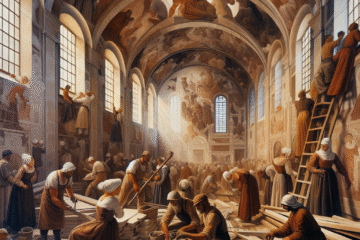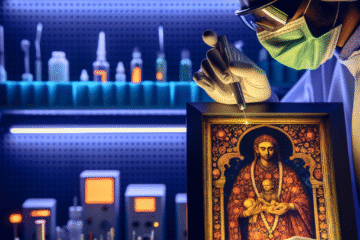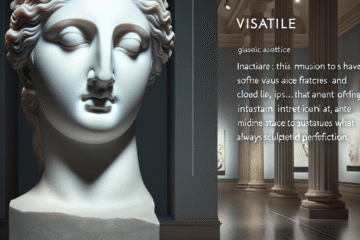I. Introduction
- Definition of the Renaissance
- Overview of the Renaissance as a period of significant cultural and artistic achievement
The Renaissance was a period of great cultural and artistic achievement that began in Italy in the 14th century and spread throughout Europe in the 15th and 16th centuries. The word “renaissance” means “rebirth” in French, and the Renaissance is often referred to as the “rebirth of classical learning and culture.” It was a time of great intellectual and artistic flourishing, and many of the most important works of art, literature, and philosophy of the Western world were created during this period.
The Renaissance was a response to the cultural and intellectual stagnation of the Middle Ages, and it was characterized by a renewed interest in the classical learning and values of ancient Greece and Rome. This interest was reflected in the art and literature of the time, which was marked by a revival of classical themes and styles. The Renaissance also saw the emergence of new artistic forms, such as the sonnet and the essay, and the development of innovative techniques in painting, sculpture, and architecture.
In addition to its artistic achievements, the Renaissance was a time of great social and political change. The growth of trade and commerce, the rise of the middle class, and the spread of humanistic ideas all contributed to the transformation of European society during this period. The Renaissance had a profound and lasting impact on the development of Western culture, and it is considered by many to be one of the most important periods in the history of art and intellectual thought.
It is important to note that the Renaissance was not a sudden or uniform development, but rather a gradual process that occurred over several centuries and varied in its expression and impact across different regions and cultures. The Renaissance was also not a uniform movement in terms of its goals and values, as different artists and intellectuals had different priorities and agendas. However, the Renaissance is generally considered to have been a time of great innovation and creativity, as well as a period of increased cultural exchange and interaction between different parts of Europe and the wider world.
II. The Renaissance in Italy
- The city-states of Italy as centers of Renaissance culture
- The role of the Medici family in supporting the arts
- The innovations and accomplishments of Renaissance artists in Italy
Italy was the birthplace of the Renaissance, and the city-states of Florence, Rome, and Venice were particularly important centers of Renaissance culture. The Renaissance began in Florence in the 14th century and spread to the other city-states in the following centuries.
The city-states of Italy were home to many of the most famous Renaissance artists and intellectuals, including Leonardo da Vinci, Michelangelo, Raphael, and Dante. These artists were supported by wealthy patrons, such as the Medici family in Florence, who commissioned and collected their works. The Medici were a powerful banking and political family who were deeply involved in the cultural life of Florence. They supported the arts through their patronage and also played a key role in the spread of Renaissance ideas and values throughout Europe.
During the Renaissance, Italian artists made important innovations and accomplished many notable achievements in a variety of artistic fields. In painting, the Renaissance saw the development of the techniques of linear perspective and chiaroscuro, which allowed artists to create more realistic and three-dimensional representations of the world. In sculpture, Renaissance artists such as Michelangelo and Donatello made significant contributions to the development of the medium. In architecture, the Renaissance was marked by the rediscovery of classical styles and the development of new forms, such as the dome and the classical column.
Overall, the Renaissance in Italy was a time of great artistic and intellectual achievement, and it had a lasting impact on the development of Western art and culture. The works of Renaissance artists continue to be highly influential and are considered some of the greatest achievements in the history of art.
III. The Spread of Renaissance Ideas
- The influence of the Renaissance on art and culture in other parts of Europe
- The role of trade and exploration in the spread of Renaissance ideas
- The incorporation of Renaissance styles and techniques in the art of non-European cultures
While the Renaissance began in Italy, its influence and ideas quickly spread to other parts of Europe and beyond. The spread of the Renaissance was facilitated by a number of factors, including trade, exploration, and the exchange of ideas through the printing press.
The Renaissance had a significant impact on art and culture in other parts of Europe, as artists and intellectuals in these regions were exposed to and inspired by the works of their Italian counterparts. The Renaissance also contributed to the growth of trade and commerce, which helped to spread ideas and cultural influences between different parts of Europe. For example, the city-states of Italy were major centers of trade and commerce, and their wealth and influence helped to spread Renaissance ideas and values throughout the continent.
The Renaissance was also shaped by the age of exploration, as European sailors and traders encountered new cultures and civilizations in the Americas, Africa, and Asia. These encounters influenced the art and culture of Europe, as artists and intellectuals were exposed to new styles, techniques, and ideas from non-European cultures. In turn, the art and culture of Europe had an impact on the rest of the world, as European styles and techniques were incorporated into the art of non-European cultures.
Overall, the spread of Renaissance ideas was a complex and multifaceted process that involved the exchange of ideas and influences between different regions and cultures. The Renaissance was a time of increased cultural exchange and interaction, and it had a lasting impact on the development of art and culture in Europe and beyond.
IV. The Legacy of the Renaissance
- The enduring impact of Renaissance art on the development of Western art
- The continuing relevance of Renaissance ideals and values in contemporary society
The Renaissance had a profound and lasting impact on the development of Western art and culture, and its influence can still be seen in contemporary society. The innovations and accomplishments of Renaissance artists have had a lasting impact on the development of Western art, and the works of Renaissance artists continue to be highly influential and widely admired.
In painting, the techniques of linear perspective and chiaroscuro developed during the Renaissance have had a lasting impact on the way that artists depict the world. The innovations of Renaissance sculptors, such as Michelangelo and Donatello, have also had a lasting impact on the medium, and the works of Renaissance architects, such as Brunelleschi and Palladio, continue to be widely studied and admired.
In addition to its artistic achievements, the Renaissance was a time of great social and political change, and its ideals and values have continued to be relevant and influential in contemporary society. The humanistic ideas of the Renaissance, which emphasized the importance of individualism, reason, and the natural world, have had a lasting impact on the development of modern democratic societies. The Renaissance also contributed to the growth of the middle class and the development of a more merit-based society, and its emphasis on education and the pursuit of knowledge has continued to be valued in contemporary culture.
Overall, the legacy of the Renaissance is evident in the enduring impact of its art and ideas on the development of Western culture. The Renaissance was a time of great innovation and creativity, and its achievements continue to be highly regarded and influential in contemporary society.
V. Conclusion
- Recap of the key points discussed in the article
- Reflection on the significance of the Renaissance as a turning point in art and cultural history
The Renaissance was a period of great cultural and artistic achievement that began in Italy in the 14th century and spread throughout Europe in the 15th and 16th centuries. It was a time of renewed interest in the classical learning and values of ancient Greece and Rome, and it was marked by a revival of classical themes and styles in art and literature. The Renaissance also saw the emergence of new artistic forms and the development of innovative techniques in painting, sculpture, and architecture.
In addition to its artistic achievements, the Renaissance was a time of great social and political change, as the growth of trade and commerce, the rise of the middle class, and the spread of humanistic ideas all contributed to the transformation of European society. The Renaissance had a significant and lasting impact on the development of Western culture, and its influence can still be seen in contemporary society.
The key points discussed in this article include the definition of the Renaissance, the role of Italy as the birthplace of the Renaissance, the spread of Renaissance ideas to other parts of Europe and beyond, and the enduring legacy of the Renaissance in the development of Western art and culture.
In conclusion, the Renaissance was a turning point in the history of art and cultural thought, and it had a profound and lasting impact on the development of Western culture. Its achievements continue to be highly regarded and influential in contemporary society, and the Renaissance remains an important period in the history of art and intellectual thought.


